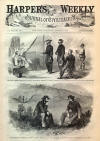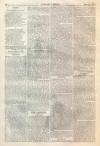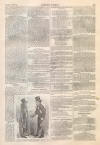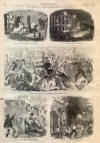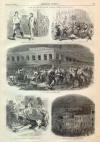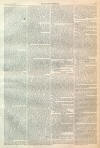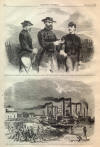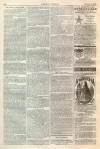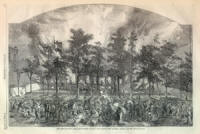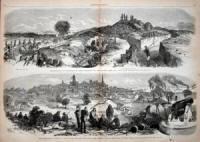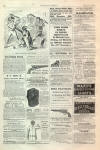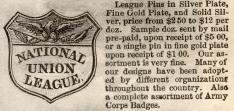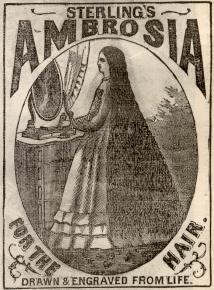Riots in New York
|
|
This Site:
|
HARPER'S WEEKLY. [AUGUST 1, 1863. 494 THE RIOTS IN NEW YORK.WE devote a considerable portion of our space this week to illustrations of the disgraceful and infamous Riot which took place in this city last week. On page 493 will be found a picture of THE BURNING OF THE COLORED ORPHAN ASYLUM,by which exploit the rioters, on Monday 13th, inaugurated their sway. This outrage is thus described in the Times: The Orphan Asylum for Colored Children was visited by the mob about four o'clock. This Institution is situated on Fifth Avenue, and the building, with the grounds and gardens adjoining, extended from Forty-third to Forty-fourth Street. Hundreds, and perhaps thousands of the rioters, the majority of whom were women and children, entered the premises, and in the most excited and violent manner they ransacked and plundered the building from cellar to garret. The building was located in the most pleasant and healthy portion of the city. It was purely a charitable institution. In it there are on an average 600 or 800 homeless colored orphans. The building was a large four-story one, with two wings of three stories each. When it became evident that the crowd designed to destroy it, a flag of truce appeared on the walk opposite, and the principals of the establishment made an appeal to the excited populace, but in vain. Here it was that Chief-Engineer Decker showed himself one of the bravest among the brave. After the entire building had been ransacked, and every article deemed worth carrying away had been taken—and this included even the little garments for the orphans, which were contributed by the benevolent ladies of this city—the premises were fired on the first floor. Mr. Decker did all he could to prevent the flames from being kindled, but when he was overpowered by superior numbers, with his own hands he scattered the brands, and effectually extinguished the flames. A second attempt was made, and this time in three different parts of the house. Again he succeeded, with the aid of half a dozen of his men, in defeating the incendiaries. The mob became highly exasperated at his conduct, and threatened to take his life if he repeated the act. On the front steps of the building he stood up amidst an infuriated and half-drunken mob of two thousand, and begged of them to do nothing so disgraceful to humanity as to burn a benevolent institution, which had for its object nothing but good. He said it would be a lasting disgrace to them and to the city of New York. These remarks seemed to have no good effect upon them, and meantime the premises were again fired—this time in all parts of the house. Mr. Decker, with his few brave men, again extinguished the flames. This last act brought down upon him the vengeance of all who were bent on the destruction of the asylum, and but for the fact that some firemen surrounded him, and boldly said that Mr. Decker could not be taken except over their bodies, he would have been dispatched on the spot. The institution was destined to be burned, and after an hour and a half of labor on the part of the mob it was in flames in all parts. Three or four persons were horribly bruised by the falling walls, but the names we could not ascertain. There is now scarcely one brick left upon another of the Orphan Asylum. Another reporter of the Times says: During the burning of the Colored Orphan Asylum a young Irishman, named Paddy M'Caffrey, with four stage-drivers of the Forty-second Street line and the members of Engine Company No. 18, rescued some twenty of the orphan children who were surrounded by the mob, and in defiance of the threats of the rioters, escorted them to the Thirty-fifth Precinct Station-house. It hardly seems credible, yet it is nevertheless true, that there were dozens of men, or rather fiends, among the crowd who gathered around the poor children and cried out, "Murder the d—d monkeys," "Wring the necks of the d—d Lincolnites," etc. Had it not been for the courageous conduct of the parties mentioned, there is little doubt that many, and perhaps all of those helpless children, would have been murdered in cold blood. On page 484 we illustrate the CHARGE OF THE POLICE UPON THE RIOTERSwho were engaged in sacking the Tribune office. We take pleasure in publishing the following graphic account of this affair from an officer who took part in it, and can personally testify to its correctness: To the Editor of Harper's Weekly; SIR,—As a variety of conflicting statements have been published in the daily papers purporting to be descriptions of the dispersion of the rioters engaged in sacking the Tribune office, a brief statement of the actual facts of that truly brilliant affair, from a participant, may possibly be not unacceptable. At seven o'clock on Monday evening the members of the 26th Precinct then present, 38 men all told, were assembled in their Squad-room, southeast corner City Hall basement. With them, at the same time and place—and constituting with the 26th a special reserve at that important point—were the reserves of the 1st Precinct, under Captain Warlow; the bulk of Captain Bryan's force (4th Precinct) having being previously ordered to police head-quarters, 300 Mulberry Street; that gallant officer was also present as a volunteer. A report, whether designedly or not, that a riot was progressing in the 1st Precinct, started first Warlow and his command, and immediately after the 26th, under Captain Thorne; on down Broadway to Beaver, or thereabout, and as through to Broad Street, when we found that the disturbance, a slight one, had been suppressed. After a brief delay we resumed our march up Broad and Nassau. Passing the Evening Post, a cheer greeted us from the building. On reaching about the corner of Beekman and Nassau a halt was quietly ordered. It was now dark, or nearly so, and through the deepening gloaming we could see the 1st Precinct men halted on the west side of Nassau, just south of the Times Buildings. They had rapped, and that was the reason of our halt. A few hurried words of consultation between Captains Thorne and Warlow, and we were again in place and ready. We could now distinctly hear the crashing of wood and glass; the work of riot and devastation had commenced, but with the earnestness and thoroughness which has marked the conduct of this outbreak from the start, there was no shouting or profane clamor. It was a storming party under competent and effective leadership. So earnest were they in their work—so absorbed, in fact, that the low, stern order, "Keep together, men; steady; now, then, Forward! Charge!" from Captain Thorne, was unheard save by a few spectators on the Times corner. With a shout from a hundred throats, the 26th leading the onset, we struck them like a thunderbolt, cleaving and scattering them in utter rout, ruin, and dismay. A few of us entered the office. They had only got as far as the ground-floor, and the few fool-hardy rebels who were found were mercilessly clubbed into the street or into insensibility, and hurriedly dragged off by friends to die in unknown homes, or linger, with maimed and shattered heads and limbs, for months and years of pain and disfigurement. The square—a minute previous crowded by a surging mass five thousand strong—was in five minutes cleared to a point below French's Hotel, save where the dead and wounded were being hurriedly dragged off by terrified friends. We did not try to take prisoners till after the first rally, except that Officer Freeman, of the 26th, finding a man, who gave his name as Burt Francis, in the act of ripping up the counter in the office, brought him in, and he was duly committed next morning. Only two more arrests were made. Victorious, but breathless, we had just succeeded in extinguishing the flames, which had by this time broke out, when a shout as from a great crowd was heard, and a mass of men were seen charging across the Park toward us from the direction of Broadway. The word was given "Stand firm!" and every man squared himself for what now seemed about to be a death-struggle with an overwhelming reinforcement of the mob. It was a supreme moment; but our suspense was immediately at an end. Soon the bright buttons and uplifted batons of our own gallant fellows from Broadway were recognized, the grizzled locks and martial figure of the Metropolitan war- horse, brave Dan Carpenter, conspicuous at their head. One loud, ringing cheer went up, while trusty batons waved, of triumph and relief. Victory was with the right. Law and order had triumphed. The importance of our coup can hardly be overestimated. The suddenness and vigor of the blow took the snap right out of the murdering thieves at the start, and effectually demoralized whatever of organization they had in the lower part of the city. The Tribune, Times, and Post would inevitably have gone as a consequence even of their partial success; and speculation stops aghast when reflecting on the possible havoc and destruction of the massed and hoarded wealth collected below Canal Street. The officers in command were Captain Thorne, 26th (City Hall) Precinct, and Captain Warlow, 1st Precinct, accompanied by Captain Bryan, 4th Precinct, as an amateur volunteer. Let their names and those of their gallant officers and men be held in grateful remembrance. One of our special artists, who was detailed to sketch the progress of the riot, thus describes the sketches he furnished, which are reproduced on pages 484 and 485: MASSACRE OF A NEGRO IN CLARKSON STREET.One of the first victims to the insane fury of the rioters was a negro cartman residing in Carmine Street. A mob of men and boys seized this unfortunate man on Monday evening, and having beaten him until he was in a state of insensibility, dragged him to Clarkson Street, and hung him from a branch of one of the trees that shade the sidewalk by St. John's Cemetery. The fiends did not stop here, however. Procuring long sticks, they tied rags and straw to the ends of them, and with these torches they danced round their victim, setting fire to his clothes, and burning him almost to a cinder. The remains of the wretched negro hung there till near daylight on Tuesday morning, when they were removed by the police. This atrocious murder was perpetrated within ten feet of consecrated ground, where the white head-stones of the cemetery are seen gleaming through the wooden railing. THE MURDER OF COLONEL O'BRIEN.As I arrived at the corner of Thirty-fourth Street and Second Avenue, the rioters were dragging the body of a man along the sidewalk with a rope. It was difficult to obtain any information from the by-standers, who were terror-struck by the savage fury of the mob. I ascertained, however, that the body was that of Colonel O'Brien of the Eleventh New York. There was not a policeman or soldier within view of whom inquiry could be made. "What did they kill him for?" I asked a man leaning against a lamp-post. "Bedad I suppose it was to square accounts," replied he. "There was a woman and child kilt there below a while ago by the sojers, and in coorse a sojer had to suffer." The brutal roughs who surrounded the body fired pistols at it occasionally, and pelted it with brickbats and paving-stones. The tenacity of life of this unfortunate victim is said to have been remarkable, and those who entered the yard where the body lay some hours later state that breathing was even then perceptible. SACKING OF A DRUG-STORE.Sated with blood, the rioters now turned their attention to plunder. A drug-store close by where Colonel O'Brien lay was completely riddled by them, the doors and windows being smashed in with clubs and stones. Women hovered upon the skirts of the crowd, and received the articles as they were thrown or handed from the store. One fellow rushed out with a closely-packed valise, which he opened in the street. The clothes and other things contained in it were eagerly seized and contended for by boys and women standing around. There were a number of letters in it, and some documents with seals, which were probably of value to the owner; but these were savagely torn and trampled under foot by the disappointed plunderers. A woman sat upon the steps near by, and read out portions of one of the letters amidst the jeers of her ribald companions. Another passed me waving in triumph a large parchment manuscript of many pages.
ATTACK UPON THE CLOTHING-STORE OF
MESSRS.
|
||||||||||||||||||||||
|
|
||
|
|
Site Copyright 2003-2018 Son of the South. For Questions or comments about this collection, contact paul@sonofthesouth.net |
|
|
Are you Scared and Confused? Read My Snake Story, a story of hope and encouragement, to help you face your fears. |
||
